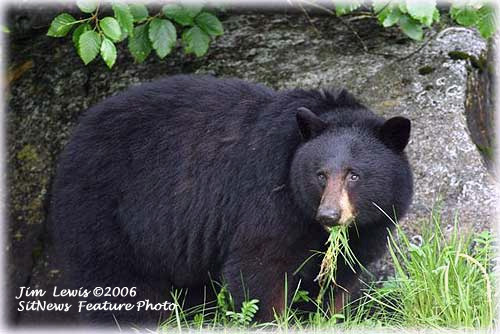
Bear species' genetic relationships determinedBy NANCY TARNAI
March 15, 2014
Matthew Cronin, professor of animal genetics with the University of Alaska Fairbanks School of Natural Resources and Extension and colleagues at the University of California Davis and Delta G Co. published a paper on bear genetics in the Journal of Heredity online in January which will be available in print later.
Southeast Alaska: Hidden Inlet Black Bear, approximately 50 air miles southeast of Ketchikan inside the Misty Fjords National Monument on the Portland Canal.
The 2014 paper replicates other research on bear genomes but includes analysis of genetic variation in more than 300 bears from Alaska and genetic elements not assessed previously in bears. These are known as ultra-conserved elements, and show the polar and brown bears to be more closely related than either is to black bears. The data was used in a “molecular clock” that uses the numbers of differences (mutations) in DNA sequences to estimate when the sequences, and hence the species, diverged. The data suggest that polar bears and brown bears diverged as different species 1.2 million years ago, and black bears diverged from the polar/brown bear lineage 2.3 million years ago. These estimates are within the ranges in other studies. Utilizing labs at the University of California Davis, Cronin and technology experts pored over huge datasets. He also analyzed tissue samples from Montana and from Alaska’s Admiralty, Baranof and Chichagof islands, obtained from state and federal wildlife agencies. In recent years DNA science has improved so much that Cronin is able to study billions of nucleotides of DNA rather than the thousands he used to be limited to. “It’s very advanced because of the applications in medicine and agriculture,” Cronin said. “The ramifications are that if the polar bear was an independent species for about 1 million years it survived previous cold and warm periods,” Cronin said. “This means the polar bear has been an independent lineage a long time through glacial and interglacial and warm periods.” The last glacial period was at maximum extent about 22,000 years ago, and was preceded by a warm interglacial period about 130,000 years ago. Other warm and cold periods preceded that. Cronin thinks that if polar bears survived previous warm periods in which there was little or no arctic summer sea ice, this should be used in models predicting the species’ response to current climate change. “It seems logical that if polar bears survived previous warm, ice-free periods, they could survive another. This is of course speculation, but so is predicting they will not survive, as the proponents of the endangered species act listing of polar bears have done.” Cronin has been studying animal genetics for 25 years. He recently researched wood bison and plains bison. Comparing wolves in Southeast Alaska to species across the country is his next area of research.
Edited by Mary Kauffman, SitNews Source of News:
E-mail your news &
photos to editor@sitnews.us
|
||
